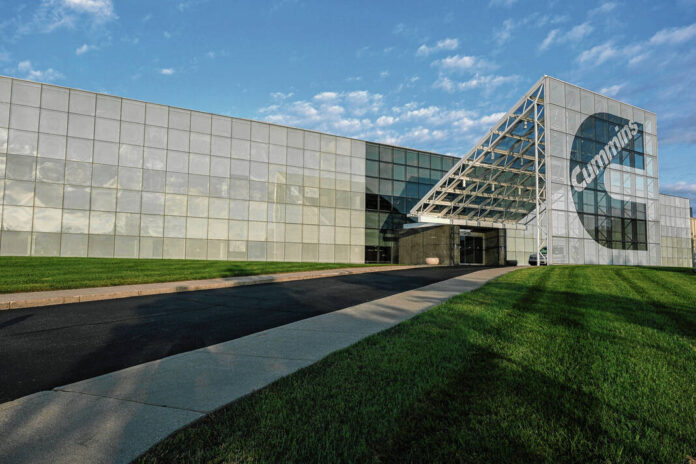
Mike Wolanin | The Republic An exterior view of Cummins Columbus Engine Plant in Columbus, Ind., Friday, Oct. 7, 2022.
A local analyst says that a potential deal for Cummins Inc. to acquire part of Faurecia’s commercial vehicle exhaust aftertreatment business, including a manufacturing facility in Columbus, could offer benefits for both companies.
Last week, Faurecia said that it was in exclusive talks to sell part of its commercial vehicle exhaust aftertreatment business in Europe and in the United States to Cummins for an enterprise value of roughly $159 to $160 million.
The potential sale would include a Faurecia facility in Columbus and Roermond, Netherlands, suggesting that at least some of Faurecia’s employees in Columbus could become Cummins employees if the deal were to be completed.
Faurecia, which is headquartered in France and operates in 33 countries, lists one location in Roermond, Netherlands on its website. Dutch public records indicate that Faurecia Emissions Control Technologies Netherlands B.V. is located in the city, which is near the border with Germany.
Faurecia said the potential deal with Cummins “would help secure long-term business” for the two facilities, specifically pointing to exhaust aftertreatment for commercial vehicles with internal combustion engines. An aftertreatment system is essentially a device that cleans exhaust gasses to ensure the engines meet emission regulations, according to Cummins.
However, the two companies have been tight-lipped on other specifics of the potential deal, including what Cummins’ plans may be for the two facilities should the deal be completed. A Faurecia spokesperson didn’t respond to a request for comment.
Cummins spokesman Jon Mills said the Columbus-based company could not comment at this time because negotiations were still ongoing.
 Jon Mills
Jon Mills
“The two companies are unable to share further details because the negotiations are ongoing, but both are committed to sharing details with key stakeholders once negotiations conclude,” Mills said in a statement to The Republic.
Potential rationales
The deal has potential upsides for both companies, said Roger Lee, a senior research analyst with Columbus-based Kirr, Marbach and Co.
 Roger Lee
Roger Lee
For Cummins, the deal could offer more control and vertical integration of its supply chain for internal combustion engines at a time when environmental regulations are poised to get stricter, Lee said.
Vertical integration is when a company controls different stages of a supply chain instead of relying on outside suppliers, which can result in, among other things, greater economies of scale, lower variable production costs and increased profitability.
“Whenever you look at any kind of acquisition, it’s got to be either very strategic and/or something that’s priced very attractively. If I had to guess, this meets both of those criteria,” Lee said. “…Emissions regulations are only getting stricter, and now Cummins can have even more control on that supply chain.”
For Faurecia, the potential sale is a chance to sell off a non-core part of its business to reduce debt amid a period of economic weakness in Europe and growing uncertainty due to Russia’s invasion of Ukraine, Lee said.
FORVIA Group, which Faurecia is part of, also has signaled that it intends to shift its business away from the internal combustion engine, with officials stating that the group’s “exposure to (the) internal combustion engine in 2025 would reduce towards 10%” should the deal with Cummins go through.
“Faurecia is a European company, and especially over the past year or two years, Europe has been in pretty rough shape given their exposure to the Ukraine-Russia crisis, “Lee said. “Their economy has been pretty weak. I think for any European company, especially that is manufacturing heavy that has debt, you definitely want to get the debt down if you’re in a period of economic weakness because if things deteriorate materially, then that debt becomes very toxic.”
‘Deleveraging’
The potential deal with Cummins is part of a roughly $1.06 billion asset-disposal program by Faurecia to reduce debt and boost its balance sheet, according to public filings.
In August 2021, Faurecia announced plans to acquire German company HELLA, a move that the companies said would create the seventh largest automotive parts supplier in the world, which was later named FORVIA Group.
The roughly $5.74 billion acquisition, which was completed in February 2022, was bankrolled through a mix of cash, newly issued Faurecia shares and debt, which prompted Faurecia to initially announce plan to dispose of $532 million “non-strategic assets” by the end of 2023 “to contribute to deleveraging post-acquisition.”
Deleveraging is when a company attempts to reduce its debt, also known as financial leverage, by raising capital or selling off assets.
However, Faurecia said this past April it would step up its asset-disposal program, raising its target to roughly $1.06 billion by the end of 2023 “to enhance financial flexibility in an environment that became increasingly uncertain after the outbreak of the war in Ukraine.”
Since then, Faurecia and HELLA have announced a series of moves to sell off assets that the companies say will help it reach the $1.06 billion target by the end of this year.
In July, HELLA said it would sell its 33% stake in a joint venture for about $308 million. In December, Faurecia announced plans to sell its interiors business in India.
Also in December, Faurecia and Michelin said they were in exclusive negotiations with Stellantis over a potential deal for Stellantis to acquire a “substantial stake” in Symbio, a Michelin and Faurecia joint venture that designs, produces and sells “hydrogen solutions” for light- and heavy-duty vehicles.
Just days after announcing the negotiations with Cummins, Faurecia said Monday that it had reached an agreement to sell its “SAS” Cockpit Modules to division to an Indian company for an enterprise value of roughly $574 million.
Faurecia officials said the announced transactions put the company on track to dispose of $1.06 billion in assets by the end of this year.
“(Faurecia) has good prospects,” Lee said. “They’re doing a lot of stuff with (electric vehicles) and clean-energy cars. (The company) is a good asset, it’s just they happen to have essentially a big mortgage on the company. And in this case, they’re just trying to free up some non-core assets and pay down some of that mortgage so that even if things stay weak, they’re not underwater.”




